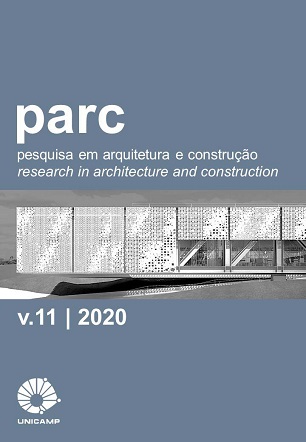Abstract
Diagrams can be used to analyze complex problems, facilitating decisions. As an example, we could mention the bioclimatic diagrams used to define guidelines for building design. However, bioclimatic diagrams are not compatible with the idea of adaptive thermal comfort. This research aimed to present diagrams to support the design process of small buildings with low energy demand and suitable for the concept of adaptive comfort. Based on an adaptive comfort model and existing diagrams, two diagrams and procedures for its application were elaborated. The diagrams were applied to the early design phases of small buildings' design process in Curitiba's climate. The results were compared with those obtained with the traditional Givoni diagram. The comparison showed that the differences between both comfort models result in different guidelines. The alternative method also allowed an adequate analysis of the daily temperature range and ordered the design guidelines' application.
References
ABNT - ASSOCIAÇÃO BRASILEIRA DE NORMAS TÉCNICAS. NBR 15.220: Desempenho térmico de edificações. Parte 3: Zoneamento bioclimático brasileiro e diretrizes construtivas para habitações unifamiliares de interesse social. Rio de Janeiro: Associação Brasileira de Normas Técnicas, 2005.
ABNT/CB-055 - ASSOCIAÇÃO BRASILEIRA DE NORMAS TÉCNICAS / COMITÊ DE REFRIGERAÇÃO, AR-CONDICIONADO, VENTILAÇÃO E AQUECIMENTO - CB-55. 3º Projeto Revisão ABNT NBR 16401-2. Rio de Janeiro: Associação Brasileira de Normas Técnicas, 2016.
ASHRAE - AMERICAN SOCIETY OF HEATING, REFRIGERATING, AND AIR-CONDITIONING ENGINEERS. ASHRAE Standard 55-2017 - Thermal Environmental Conditions for Human Occupancy. USA, Atlanta: 2017.
AULICIEMS, A. Psycho-Physiological Criteria for Global Thermal Zones of Building Design. International Journal of Biometeorology, v. Complement, p. 69–86, 1983.
BOGO, A.; et al. Bioclimatologia Aplicada ao Projeto de Edificações Visando o Conforto Térmico. Relatório Interno - 02/94. Florianópolis: 1994.
DE DEAR, R.; BRAGER, G.; COOPER, D. Developing an adaptive model of thermal comfort and preference - Final Report on RP-884. Sydney: ASHRAE, 1997.
EVANS, J. M. Evaluating comfort with varying temperatures: a graphic design tool. Energy and Buildings, v. 35, p. 87–93, 2003. DOI: https://doi.org/10.1016/s0140-6701(03)92067-4
GIVONI, B. Comfort, climate analysis and building design guidelines. Energy and Buildings, v. 18, n. 1, p. 11–23, 1992.
JUNKER, M.; KOLLER, T.; MONN, C. An assessment of indoor air contaminants in buildings with recreational activity. Science of the Total Environment, v. 246, n. 2–3, p. 139–152, 2000. DOI: https://doi.org/10.1016/s0048-9697(99)00452-0
KRÜGER, E. L. et al. Proposition of a simplified method for predicting hourly indoor temperatures in test cells. Ambiente Construído, v. 17, n. 3, p. 57–70, 2017. DOI: https://doi.org/10.1590/s1678-86212017000300162
LABEEE – LABORATÓRIO DE EFICIÊNCIA ENERGÉTICA EM EDIFICAÇÕES. Analysis Bio. Versão 2.2. Florianópolis: LABEEE, 2010. Disponível em: https://labeee.ufsc.br/downloads/softwares/analysis-bio.
NICOL, F.; HUMPHREYS, M. Adaptive thermal comfort and sustainable thermal standards for buildings. Energy and buildings, v. 34, n. 6, p. 563-572, 2002. DOI: https://doi.org/10.1016/S0378-7788(02)00006-3
OLGYAY, V. Arquitectura y Clima. Manual de diseño bioclimático para arquitectos y urbanistas. 5a ed. Barcelona: Gustavo Gili, 2008.
PEREIRA, I. M.; ASSIS, E. S. De. Avaliação de modelos de índices adaptativos para uso no projeto arquitetônico bioclimático. Ambiente Construído, v. 10, n. 1, p. 31–51, 2010. DOI: https://doi.org/10.1590/s1678-86212010000100002
RUBEL, F.; KOTTEK, M. Comments on: “The thermal zones of the Earth” by Wladimir Köppen (1884). Meteorologische Zeitschrift, v. 20, n. 3, p. 361–365, 2011. DOI: https://doi.org/10.1127/0941-2948/2011/0258
SZOKOLAY, Steven.V. Introduction to architectural science: the basis of sustainable design. 2 ed.: Elsevier Ltd., 2008.
VELLEI, M. et al. The influence of relative humidity on adaptive thermal comfort. Building and Environment, v. 124, p. 171–185, 2017. DOI: https://doi.org/10.1016/j.buildenv.2017.08.005
VERBEKE, S.; AUDENAERT, A. Thermal inertia in buildings: A review of impacts across climate and building use. Renewable and Sustainable Energy Reviews, v. 82, n. November 2016, p. 2300–2318, 2018. DOI: https://doi.org/10.1016/j.rser.2017.08.083
ZÖLD, A.; SZOKOLAY, S. PLEA Note 2: Thermal Insulation. Passive and Low Energy Architecture International, 1997.

This work is licensed under a Creative Commons Attribution 4.0 International License.
Copyright (c) 2020 PARC Research in Architecture and Building Construction


